Description of diseases and pests of apple trees
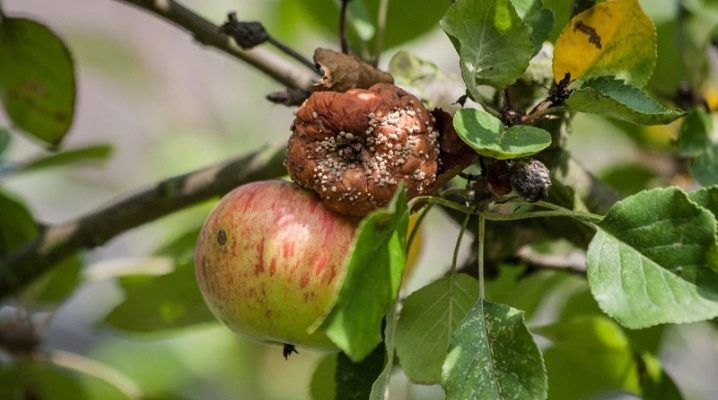
The apple tree is a popular fruit crop among gardeners. It can be found in many summer cottages. But at the same time, such trees are often affected by various diseases.
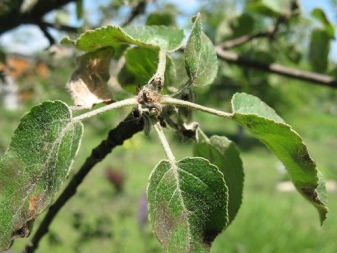
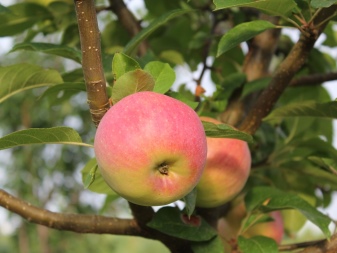
Diseases and their treatment
Next, we will analyze the main diseases of apple trees, their detailed description, signs of appearance, as well as methods of treatment.
Fruit rot
This disease is also called "Moniliosis". In this case, brown spots begin to appear on the fruits. After a couple of weeks, they become completely rotten. In the future, the diseased fruit either simply falls off, or remains in this form hanging on the tree. Most often, fruit rot appears in the middle of summer. High humidity contributes to the rapid spread of the disease. The main source is the harmful fungus. It should be noted that it is quite difficult to identify rot in the early stages.
Fruit rot is treatable. In this case, it is better to use a solution with iodine. You can also use the drug "Fitosporin", and this should be done about a month before harvesting the fruit. Sometimes the drug "Hom" is also used - the substance (40 grams) is diluted in a bucket of water. The finished composition is sprayed on infected trees.
In this case, one plant should have about 5-6 liters of such a solution.
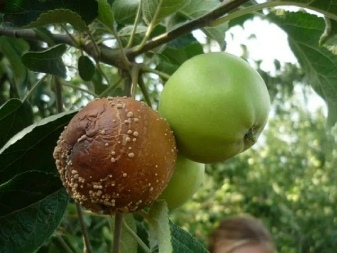
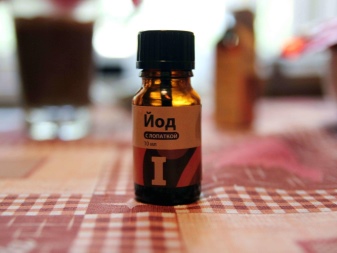
Powdery mildew
This disease is also fungal. When infected, they are damaged first. shoots and leaves. The leaf blades gradually begin to fade and curl. Further, they are covered with a bloom of white. In the future, these parts of the tree may turn brown. Powdery mildew can also damage flowers. They take on a shapeless appearance, and then simply dry up. In this case, you should not wait for the harvest. If you do not start treatment in a timely manner, the plant will quickly die.
The apple tree can get sick in early spring. Young tissues are most susceptible to disease. To cure a tree, you must first cut off all affected branches, and they must be burned so as not to spread the infection further. After that, spraying with chemicals is carried out.
Rubigan, Impact, Karatan and Nimrod will be best suited. Solutions should be prepared in strict accordance with the instructions.
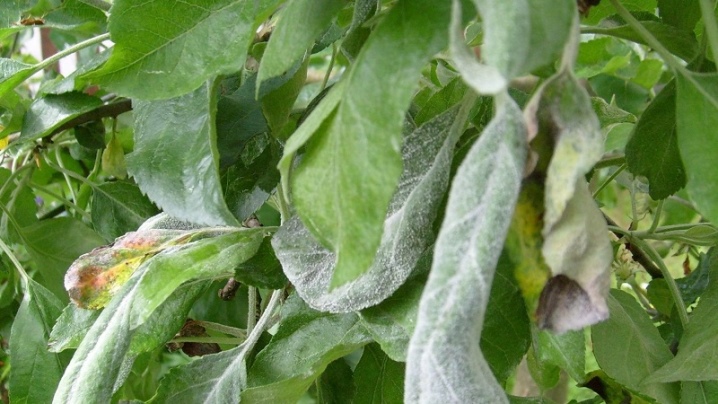
Phylostictosis
When this disease is affected, small brown spots begin to appear on the surface of the leaves, therefore phyllostictosis is also called brown spot. The main source is fungus.
To prevent the appearance of such an infection, fallen leaves should be removed from the site in a timely manner, the trunk circle should be dug up, and the crown should be thinned... To fight phyllostictosis, you can use a composition with urea (5%). Bordeaux liquid can also help, which in this case acts as a strong fungicide.
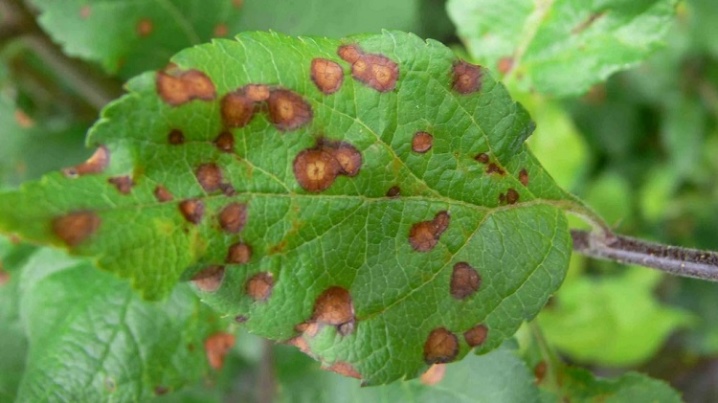
Scab
Scaly brown spots appear on the leaves of the apple tree. Plaques with a rough surface begin to form on the fruit. The scab does not cause the death of the crop, but at the same time it negatively affects its presentation.
The most effective means in the fight against scab are special biological fungicides "Horus", "Fitolavin" and "Fitosporin". The finished solution is sprayed onto the crown and trunk. Moreover, it is necessary to carry out several such treatments in order to get rid of the infection.
As a preventive measure, you can perform treatments using Bordeaux liquid (3%).
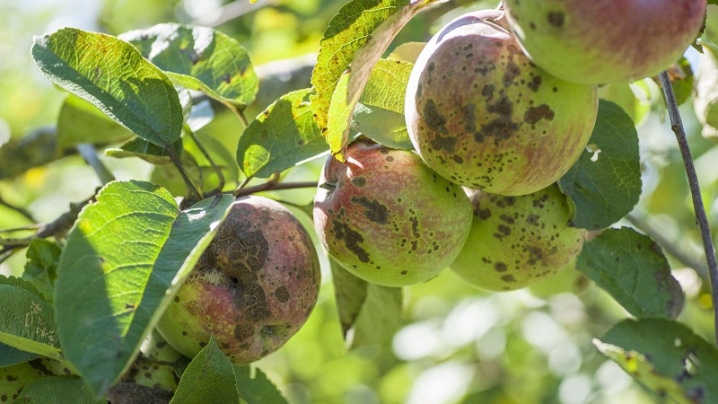
Black cancer
When damaged by black cancer, spots of brown-red color appear on the bark of fruit trees. Further, a large number of small black dots are formed. The bark gradually begins to crack, charcoal, and its stratification occurs. The wood is then exposed. To cure a plant, you need to take action immediately after detecting the above signs. All affected areas neatly cut and incinerated immediately. After that, the tree must be sprayed with copper sulfate (concentration 2%).
All cut points also need to be processed. For this, it is better to use Bordeaux liquid. If black cancer appears on the tree again, then it is better to completely remove the plant from the site.
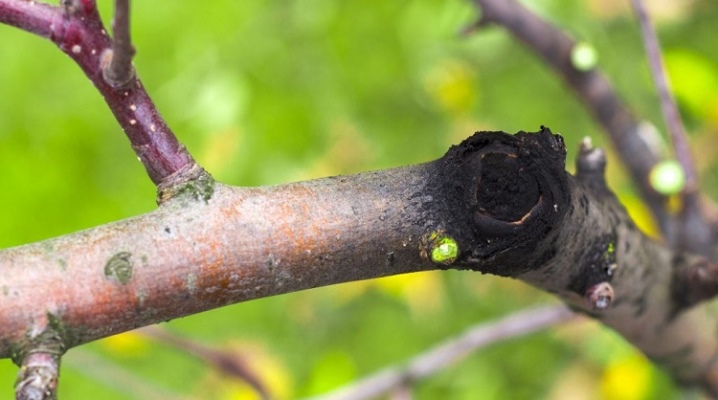
Mosaic disease
If affected, lighter spots can be seen on the leaf blades of apple trees. In the future, the affected foliage begins to shrink, then it will turn yellow and simply fall off. Shoot growth is greatly slowed down. The yield and quality of apples also decrease. Mosaic disease is viral. As a rule, this disease cannot be treated; it is better to remove the plant from the site immediately.
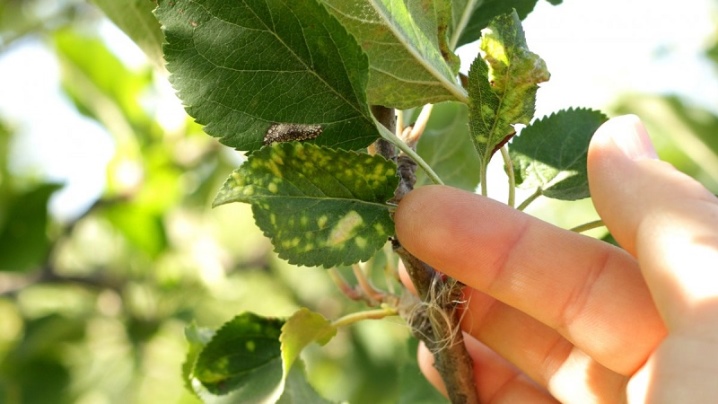
Paniculate
This disease is also viral.... It usually occurs in the middle of summer. At the same time, thin shoots with small leaves appear on the tree. Infected plants develop buds late. Flowers will be irregular. As a result, the fruits grow small, they practically have no taste.
The paniculate is incurable, so the affected fruit tree will have to be uprooted and burned immediately.
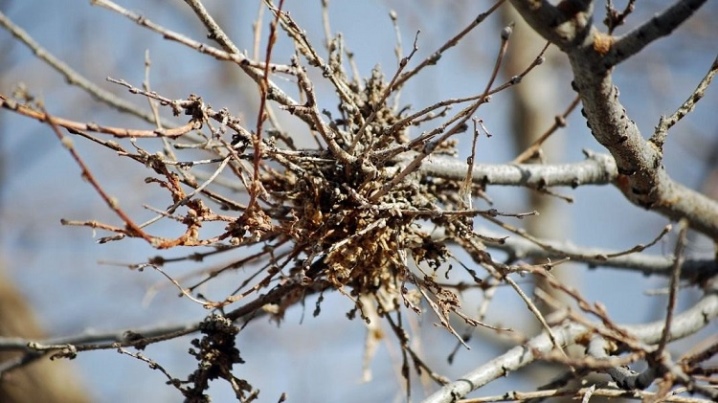
Cytosporosis
Damage appears directly on the bark of the tree... Colonies of harmful fungi actively develop under it. Only brown spots will be visible on its surface. Further, they will begin to brighten and acquire a red tint. The surface of the bark will crack, and the trunk will lose its hardness and strength. At the same time, the branches will begin to break. When signs of disease are found, all damaged parts of the trees are carefully cut. Moreover, all the places of the cuts are immediately treated with a solution of copper sulfate.
The trunk must be whitewashed with lime. It is recommended to apply mineral fertilizers to the soil. Further, treatments are carried out with copper sulfate or fungicide. In total, you will need to perform at least three such procedures.
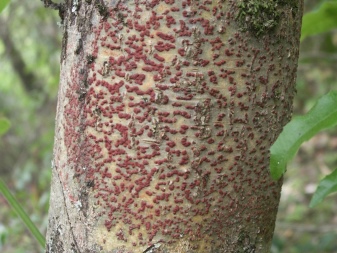
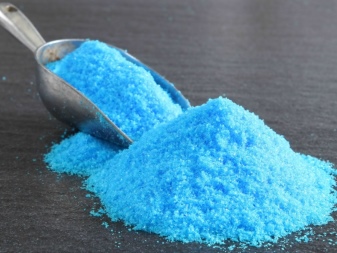
Bacterial burn
With such a bacterial disease, all aerial parts of the apple tree can be affected. Leaves, shoots turn brown, flowers also darken, young shoots take on a curved shape. The bark splits and comes off healthy wood.
To heal the affected plant, it is necessary remove infected parts. They are cut to healthy wood. If the apple tree is too badly affected, it will have to be uprooted and burned. Also, vegetation is treated with chemicals that contain copper.
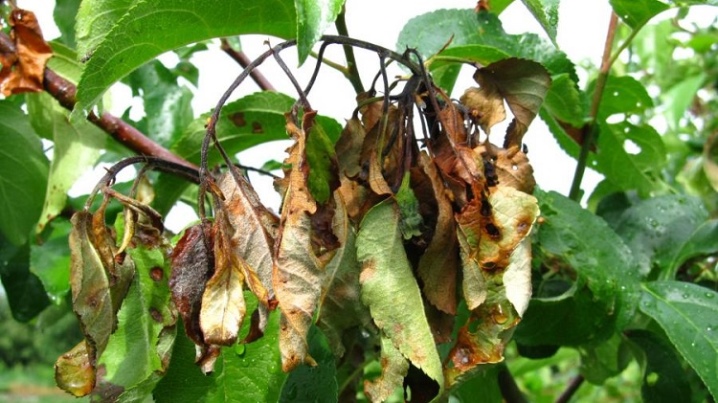
Pests and the fight against them
The apple tree is often affected by various parasites.
- Leaf rollers... Such small insects hide under the foliage. They can appear on the tree from early spring. Leaf rollers can also severely damage apple buds and shoots. They drag the plants with their cobwebs. To get rid of such a pest, you can use a solution of "Nitrofen", after budding, "Chlorophos" is used.
- Apple moth. The pest affects the fruit. Small caterpillars of light color penetrate the apples. Most often, the codling moth appears in the southern regions. With a strong defeat, bites will be visible on the fruit; when cutting, it will be possible to see parasites that gnaw their passages and eat away the seeds. To get rid of this pest, it is better to use chemical insecticides. The most effective drugs will be Iskra, Fufanon, Calypso, Mavrik, Fosban and Sirocco.Sometimes special pyrethroid formulations are used: "Arrivo", "Ivanhoe", "Tsi-Alpha", "Tsipi Plus".
- Blood aphid. The insect is able to suck out all the juices from shoots and branches, while it introduces its saliva, which provokes tissue overgrowth. As a result, the bark on the tree begins to crack, and parasites enter it. To destroy blood aphids, you can use the following drugs: "Zolon", "Kinmix", "Decis". Previously, such substances are diluted in water according to the instructions and sprayed on the affected apple trees.
- Spider mite. These small insects are of two types, some have a red body, which is completely covered with bristles, the latter have a yellow-green color. Their size, as a rule, does not exceed 0.6 mm. Spider mites attack the leaf plates on apple trees first. As a result, the foliage turns yellow, begins to dry out and fall off. The fruit will grow much more slowly. The pest can appear on trees during flowering. To combat such an insect, special acaricides are used, including "Sunmite", "Neoron". In this case, the drugs will need to be changed periodically. Otherwise, the parasites can become addictive.
- Apple blossom beetle. It is capable of causing great harm to fruit crops in a cool spring. The pest severely damages young buds. It looks like a small beetle, the length of which reaches only 4-5 millimeters. The females of the parasite lay their eggs in the buds, as a result, a large number of small white larvae appear on the trees, they also feed on the buds. To destroy the flower beetle on apple trees, you can use ready-made preparations "Fufanon", "Karbofos". During the growing season, it is worth two treatments. At the same time, about 2 liters of the composition should fall on one young tree, and at least 5 liters for a fruiting tree. Next year, it is recommended to cut off and burn all the buds that have not bloomed.
- Apple sawfly... The pest is yellow in color. Its body length can reach 7 millimeters. The females of the parasite feed on pollen; they lay their eggs inside the flowers. The insect can destroy the seed chamber in the fruit. Affected fruits fall off quickly. Treatment with "Zolon" can help against the sawfly.
- Apple gall midge... The pest is a fly no more than 2 mm long. Females lay their eggs at the edges of the foliage. The larvae feed on young leaf plates. If damaged, all old and damaged parts should be removed immediately. Then processing is carried out. For this, preparations containing phosphorus will be best suited. Biological pesticides can also be used and must be applied during oviposition.
- Hawthorn... It most often damages hawthorn, which is why it got this name, but it can also affect apple trees. The parasite quickly gnaws at foliage, young shoots and buds, significantly reducing yields. The hawthorn becomes a butterfly in summer. It leaves eggs on the surface of the bark, so the next season new pests appear on the crop again. To remove them, you can use biological insecticides, including "Karbofos", "Nitrofen" and "Benzophosphate".
- Medianitsa... It looks like a small insect about 3 millimeters long. Her colors are yellow-green. In the spring, it appears on the bark and begins to feed on young buds. Further, the copperhead flies away, but arrives again in the fall to lay the larvae on the damaged plant. To treat the affected culture, you should use the "DNOC" agent. After the flowering period, the vegetation is additionally treated with a medicinal composition with tobacco dust, and the insecticide "Fufanon" is also sometimes used.
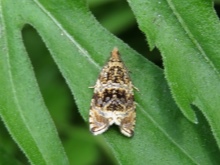
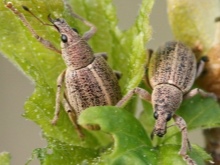
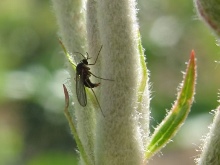
Prevention measures
To prevent the appearance of various diseases and pests on a given crop, it is worth remembering some important preventive measures. Regularly, you need to carefully inspect all fruit trees on the site.All old and damaged branches are immediately removed and burned so that they do not become a source of various infections. All sections are processed with copper sulfate or a composition with potassium permanganate to protect them from infection.
In autumn, plants must be treated with whitewash. This will protect the crop from burns. In the spring, it is worth carrying out preventive treatments. Also at this time of year, you can sprinkle the apple tree with a composition with colloidal sulfur. Prevention in the summer season plays an important role. So, in the month of June, it is recommended to use herbal infusions. You can prepare a composition with wormwood.
The drug "Inta-vir" is also used (1 tablet per 10 liters of water).
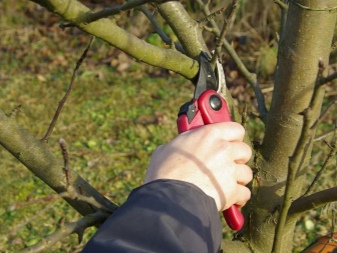

To prevent the appearance of pests that gnaw the leaves of apple trees, you can use an infusion with tobacco. It is better to use ready-made preparations in July. "Alatar", "Fitosporin", "Karate", "Karbofos"... Most often, the procedure is performed by simple spraying. Moreover, it is better to do it in dry evening weather. Fungicides can be used as a preventive measure. Iron sulfate is often used. But such a drug can be used once only at certain times - either in late autumn or early spring.
During fruiting, apple plantings can also be processed. But it is categorically impossible to use strong chemical compositions, since they can negatively affect the quality and taste characteristics of the fruits.... In this case, homemade folk remedies will be the best option. So, you can make a solution with ammonia, onion peels, and chopped garlic.
For planting in your summer cottage, you should immediately select the varieties that are most resistant to diseases and pests: Dream, Antonovka, Pervinka, Brown New. Among the decorative columnar varieties, the most resistant varieties are "Medok", "Vasyugan"... In this case, it is better to spray seedlings with fungicides even before planting.
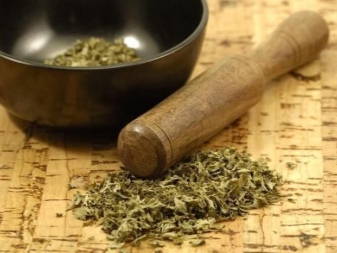
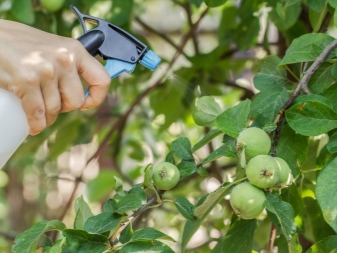







The comment was sent successfully.